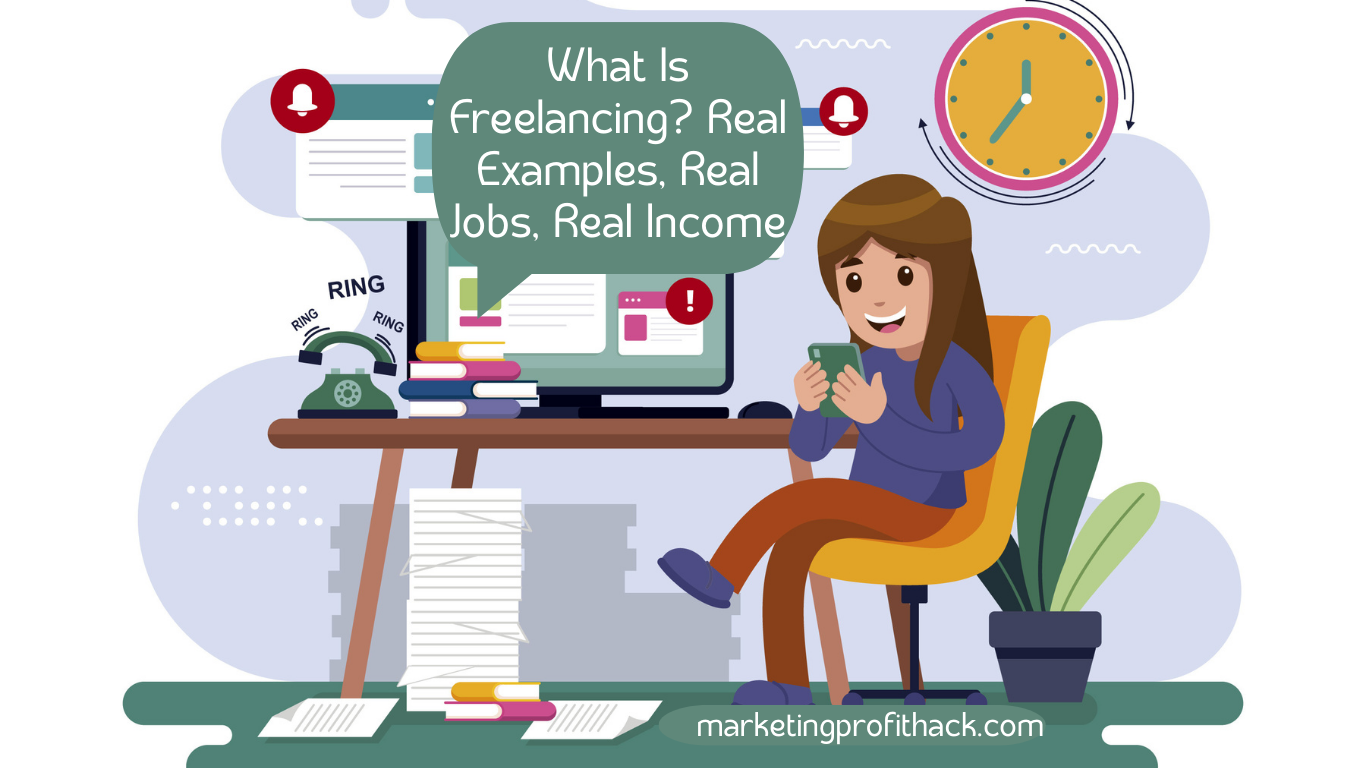Welcome to my article “What Is Freelancing? Real Examples, Real Jobs, Real Income.” So, what exactly is freelancing? Is it just working in your pajamas while sipping overpriced coffee and ignoring the fact that it’s Tuesday? Well… sort of. But there’s more to the story. Freelancing is essentially being your own boss—offering your skills and services to clients without being tied down to a 9–5 cubicle or a boss who still thinks fax machines are cool. Whether you’re a writer, designer, developer, or even a voice actor who can imitate a cat (yes, that’s a real gig), freelancing opens the door to making money on your own terms.
Unlike traditional jobs where you have one employer and one role, freelancers can juggle multiple clients, wear different hats (sometimes simultaneously), and work from anywhere with Wi-Fi—including a beach in Bali or your couch covered in yesterday’s snacks. The beauty of freelancing lies in its flexibility. But don’t be fooled—freelancing isn’t just lounging around in sweatpants and “manifesting money.” It requires real skills, real hustle, and yep, real responsibilities (like doing your own taxes—ugh).
In this blog, we’re breaking down what freelancing really looks like—with real-world examples of what freelancers do, the kinds of jobs out there, and how much money people are actually making. Spoiler alert: some freelancers are earning six figures, while others are just happy to pay rent and buy fancy dog treats. Whether you’re curious, considering the switch, or already knee-deep in Upwork proposals, this guide will give you a clear picture of what freelancing is all about—no corporate jargon, just the truth (with a side of humor).
Proven Formula for $50-$100 Daily Income with 0 COST – Watch This FREE Video >>

What Is Freelancing? (Definition + How It Works)
Let’s start with the basics. Freelancing is a way of working where you’re self-employed, not bound to any one company, and you get paid to provide a service or skill to clients—usually on a project or contract basis. You’re basically the boss, the employee, the marketing team, and the customer service rep… all rolled into one surprisingly caffeinated human.
In simpler terms: You do work for people. They pay you. Then, you do a little happy dance (optional but encouraged).
Freelancers can work in just about any industry that allows for remote or contract work—writing, design, programming, marketing, video editing, consulting, customer service, and even niche stuff like naming people’s businesses or writing dating profiles (yes, really). You’re not hired as a permanent employee; instead, you take on gigs—short-term or long-term jobs that fit your schedule, skill level, and sometimes, your mood.
Now, how does freelancing actually work?
You find a client (or they find you), agree on a rate, do the work, and get paid. Sounds simple, right? Well… mostly. You also need to pitch your services, write proposals, manage your time, invoice clients, and occasionally explain to your family that no, you don’t just “sit on the internet all day.”
There are platforms like Upwork, Fiverr, and Freelancer.com that help connect freelancers with clients—kind of like Tinder, but for work (and hopefully fewer awkward conversations). You can also go direct, reaching out to businesses or building your own website to showcase your skills.
At the end of the day, freelancing is about freedom, flexibility, and figuring things out as you go—with a good Wi-Fi connection and maybe a strong cup of coffee as your loyal sidekick.
Popular Freelance Jobs (Real Roles People Get Paid For)
If you think freelancing is just for writers and graphic designers, think again. Freelancing is like a giant buffet of money-making skills—there’s something for everyone. Whether you’re a word wizard, a code ninja, or someone who just really, really loves organizing spreadsheets (yes, those people exist), there’s probably a freelance job out there with your name on it.
Here’s a taste of some real roles people are getting paid for—some even while wearing pajamas and sipping a smoothie the size of their ego:
✍️ Writing & Editing
From blog posts to website copy, ghostwriting, and proofreading, freelance writers are everywhere. Businesses need words, and they’ll pay you to write them—especially if you can spell “definitely” without autocorrect. Editors, too, are in demand for polishing content and making it sparkle like a vampire in a teen novel.
🎨 Graphic & Web Design
Designers bring brands to life. Logos, social media graphics, websites, pitch decks—if it looks good, a freelancer probably made it. Bonus: you get to argue passionately about fonts and feel justified.
💻 Web Development & Programming
Coders are the rockstars of the freelance world. Whether it’s building websites, fixing bugs, or creating apps, developers are in constant demand. Plus, you get to say things like “JavaScript issue” and sound incredibly smart at parties.
Proven Formula for $50-$100 Daily Income with 0 COST – Watch This FREE Video >>
📣 Digital Marketing & SEO
Love analytics, content strategy, or running ads that follow people around the internet? Welcome to freelance digital marketing. Clients will pay you to grow their traffic, improve their SEO, or make their brand go viral (without involving a cat—unless it helps).
📞 Virtual Assistance & Admin Support
Not glamorous, but oh-so-essential. Freelance virtual assistants help with inbox management, scheduling, research, and other behind-the-scenes magic. You basically get paid to be someone’s organizational superhero.
🎤 Other Cool & Unexpected Jobs
Voiceover work, video editing, podcast production, online tutoring, resume writing, translating, social media managing—the list goes on. If it can be done with a laptop and Wi-Fi, someone out there is freelancing it.
So yes, people are out here earning real money for real skills. Sometimes weird skills. But hey, if someone can get paid to name other people’s babies (true story), imagine what you could do with the skills you already have.
Real Freelancing Platforms Where You Can Find Work
So, you’ve got the skills. You’re hyped. You’ve brewed a strong cup of coffee and maybe even made a vision board. Now the big question: where the heck do you actually find freelance work?
Good news—you don’t have to walk around with a “Will Write Blogs for Food” sign. The internet has your back. There are tons of freelancing platforms designed to connect you with clients who are actively looking for help. Think of them as online marketplaces for talent—like Amazon, but instead of ordering socks, people are ordering your brainpower.
Here are some of the most popular (and legit) platforms where freelancers find paid gigs:
🧑💼 Upwork
One of the biggest freelancing platforms on the planet. You can find everything from one-off logo designs to long-term content writing contracts. Create a profile, submit proposals, and if the client likes your pitch, boom—you’re in. Bonus: it tracks your time, handles payments, and even sends passive-aggressive reminders about deadlines.
🎯 Fiverr
Started as a “$5 gig” site, but now? Freelancers are charging hundreds—even thousands—for premium packages. Fiverr is more like a storefront: you list your services, and buyers come to you. It’s perfect if you want to set your own offers and flex your creative muscles. (Yes, you can sell a jingle about hot dogs. It’s been done.)
👩💻 Freelancer.com
Another giant in the freelance arena. Clients post jobs, and freelancers bid on them. It’s great for a variety of industries—from software development to marketing to legal writing. Just don’t go too wild with lowball bids; your time is worth more than a half-eaten burrito.
💡 Toptal
This one’s for the high-level experts. Toptal screens freelancers through a rigorous process—only the top 3% make it in. But if you’re a senior designer, developer, or finance pro, it’s worth the challenge. Also, you get to casually say, “I’m on Toptal” and sound like a genius.
🌍 PeoplePerHour, Guru, and Others
Smaller platforms like PeoplePerHour and Guru are still great places to find work, especially if you’re in niche industries or just starting out. They don’t get as much buzz as the big names, but sometimes the smaller ponds have less competition (and fewer sharks).
The key to success on any platform? Build a killer profile, showcase your work, be responsive, and most importantly—deliver quality. Oh, and maybe don’t ghost clients. They remember that stuff.
Whether you’re aiming for a side hustle or a full-time income, these platforms are where real freelancers start (and grow) their journey—one gig, one five-star review, one awkward video call at a time.
Real Income Potential: How Much Do Freelancers Actually Make?
Ah yes, the million-dollar question—sometimes literally. How much can you actually make as a freelancer? Well, the short answer is: it depends. The longer answer is: it really, really depends—on your skills, your niche, your rates, your hustle level, and possibly your ability to respond to emails before noon.
Let’s break it down.
💸 The Range Is Wild
Some freelancers are raking in six figures a year, living their best life from Bali or their basement (no judgment). Others are earning a few hundred bucks a month doing side gigs after work or on weekends. According to platforms like Upwork, top freelancers in fields like software development, consulting, or design can earn $50–$150/hour, while beginners in writing, admin, or marketing might start around $10–$30/hour and build from there.
But here’s the kicker: as a freelancer, you set your own rates. That means no awkward salary talks, no annual 2% raises—just you, your skills, and what the market’s willing to pay. And once you build a solid portfolio, get great reviews, and find clients who get it, your rates can rise faster than your caffeine intake on deadline day.
🧠 Skills + Strategy = $$$
It’s not just about what you can do—it’s about how you market it. Two people with the same skillset might earn totally different incomes because one knows how to write killer proposals, upsell clients, and politely say, “I charge extra for that.” (Pro tip: always charge extra for that.)
And remember, freelancing is a business. You might have dry spells or land a $2,000 project out of nowhere. Some months are ramen, others are filet mignon. That’s just part of the game.
🤑 Passive Income Perks
Once you’re established, you can start thinking about scaling: building a team, creating digital products, selling courses, or turning your services into repeatable packages. That’s when things get really fun—and really profitable.
Proven Formula for $50-$100 Daily Income with 0 COST – Watch This FREE Video >>
So, how much can you make freelancing? As little or as much as you want—if you’re willing to put in the work, sharpen your skills, and send a few too many “just following up” emails. It’s not always easy, but it’s absolutely possible.
Is Freelancing Right for You? Pros, Cons, and Final Thoughts
Freelancing sounds dreamy, right? Flexible hours, no annoying boss breathing down your neck, working from your couch in yesterday’s hoodie… But before you go quitting your job and announcing your new “solopreneur” status on LinkedIn, let’s talk real talk. Freelancing isn’t for everyone—and that’s okay.
Let’s weigh the good, the bad, and the “do I really have to send another invoice?” of it all.
✅ The Pros (AKA Why Freelancing Feels Like Freedom)
- Flexibility. Want to work at midnight? Prefer Wednesdays off? Go for it. You’re the boss now.
- Variety. You can work on different projects, with different clients, in different industries. Boredom? Never heard of her.
- Income potential. There’s no salary cap. If you’re good, marketable, and slightly obsessed with your calendar, the sky’s the limit.
- Location independence. Work from your bed, a beach, or that one coffee shop with the dangerously strong espresso. As long as there’s Wi-Fi, you’re good.
- Skill growth. You’ll learn fast—sometimes the hard way. But you’ll come out smarter, savvier, and weirdly passionate about online contracts.
❌ The Cons (AKA Stuff You Should Know Before You Leap)
- No steady paycheck. Feast and famine is real. One month you’re flush, the next you’re Googling “how to turn rice into a gourmet meal.”
- You wear all the hats. Marketer, accountant, customer service rep, therapist (to yourself). It’s all you.
- Isolation. Working solo can get lonely. Your plants become your coworkers. Some are better listeners than others.
- Self-motivation required. No one’s going to yell at you to get stuff done—but that also means Netflix won’t stop you either.
- Client management. Let’s just say… not every client is a dream client. Some think “urgent” means “I emailed you five minutes ago.”
🤔 So, Is It for You?
If you’re self-motivated, adaptable, and not afraid of occasional uncertainty, freelancing can be wildly rewarding. It gives you freedom, creativity, and the ability to build a life (and income) on your own terms. But it’s not all lattes and laptop stickers. It takes hustle, discipline, and a willingness to learn from every “oops” along the way.
Final thought? Freelancing is a lifestyle—not just a job. If you’re ready to bet on yourself, grow your skills, and laugh in the face of traditional 9-to-5s, then hey—maybe it is time to update that LinkedIn status.
Conclusion: So, Is Freelancing for You?
By now, you’ve probably figured out that freelancing isn’t just some mysterious internet hustle where people get paid to sip coffee and stare meaningfully at laptops in cafes (although, yes, that is definitely part of the aesthetic). It’s real work, with real clients, real deadlines—and yes, real income.
Whether you’re looking to ditch the 9-to-5, earn some extra weekend cash, or build your own empire from the comfort of your couch, freelancing gives you the keys to a flexible, self-driven career. You choose your hours, your projects, your clients (and occasionally your sanity levels). You can work in your pajamas, in a coworking space, or halfway up a mountain—Wi-Fi permitting, of course.
But let’s be real: freelancing isn’t a magic ATM. It takes time to build a reputation, land consistent work, and figure out that perfect work-life balance (hint: don’t schedule six deadlines on a Monday). The good news? There’s never been a better time to start. The tools, the platforms, and the clients are already out there—you just need to show up.
So go ahead. Polish up that portfolio, make an Upwork profile, and finally charge what you’re worth. Freelancing is what you make it. And who knows? This time next year, you might be one of those cool success stories people blog about. 🧑💻✨
Would you like help formatting this full article or optimizing it for SEO (headings, keywords, meta description, etc.)?
Proven Formula for $50-$100 Daily Income with 0 COST – Watch This FREE Video >>
Thanks a lot for reading my article on “What Is Freelancing? Real Examples, Real Jobs, Real Income“ till the end. Hope you’ve helped. See you with another article.










